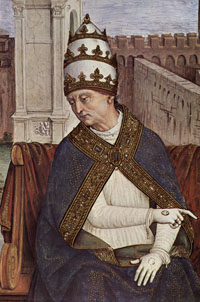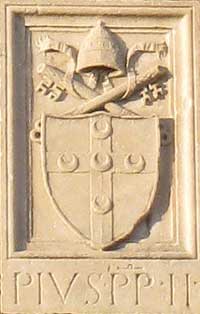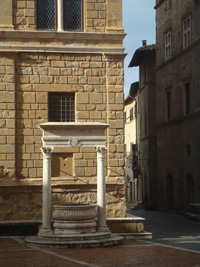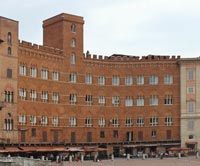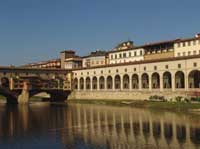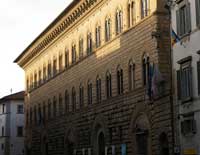| |
|
Pope Pius II, born Enea Silvio Piccolomini (Latin Aeneas Sylvius; October 18, 1405 – August 14, 1464) was Pope from August 19, 1458 until his death in 1464. Pius II, "whose character reflects almost every tendency of the age in which he lived", was born at Corsignano in the Sienese territory of a noble but decayed family. His longest and most enduring work is the story of his life, Commentaries, which is the only autobiography ever written by a reigning Pope.
Early life
|
After studying at the universities of Siena and Florence, he settled in the former city as a teacher, but in 1431 accepted the post of secretary to Domenico Capranica, bishop of Fermo, then on his way to the Council of Basel (1431–39). Capranica was protesting against the new Pope Eugene IV's (1431–1447) refusing him the cardinalate for which he had been designated by Pope Martin V (1417–1431). Arriving at Basel after enduring a stormy voyage to Genoa and then a trip across the Alps, he successively served Capranica, who ran short of money, and then other masters.
In 1435 he was sent by Cardinal Albergati, Eugenius IV's legate at the council, on a secret mission to Scotland, the object of which is variously related even by himself. He visited England as well as Scotland, underwent many perils and vicissitudes in both countries, and has left a valuable account of each. The journey to Scotland proved so tempestuous that Piccolomini swore that he would walk barefoot to the nearest shrine of Our Lady from their landing port. This proved to be Dunbar, and the nearest shrine 10 miles distant at Whitekirk. The journey through the ice and snow left Aeneas afflicted with pain in his legs for the rest of his life. In Scotland he had his second natural child, the other one having been born in Strasburg.
Upon his return to Basel, Aeneas sided actively with the council in its conflict with the Pope, and, although still a layman, eventually obtained a share in the direction of its affairs. He supported the creation of the antipope Felix V (1439–1449), Amadeus, Duke of Savoy, participating in his coronation. Aeneas then withdrew to the Emperor Frederick III's (1440–1493) court at Vienna. He had been crowned imperial poet laureate in 1442, and he obtained the patronage of the Emperor's chancellor, Kaspar Schlick. Some identify the love adventure at Siena Aeneas related in his romance, The Tale of the Two Lovers with an escapade of the Chancellor.
Aeneas' character had hitherto been that of an easy and democratic-minded man of the world, with no pretense to strictness in morals or consistency in politics. He now began to be more regular in the former respect, and in the latter adopted a decided line by making his peace between the Empire and Rome. Being sent on a mission to Rome in 1445, with the ostensible object of inducing Eugenius to convoke a new council, he was absolved from ecclesiastical censures, and returned to Germany under an engagement to assist the Pope. This he did most effectually by the diplomatic dexterity with which he smoothed away differences between the papal court of Rome and the German imperial electors; and he had a leading part in the compromise by which, in 1447, the dying Eugenius IV accepted the reconciliation tendered by the German princes, and the council and the antipope were left without support. He had already taken orders, and one of the first acts of Eugenius IV's successor Pope Nicholas V (1447–1455) was to make him bishop of Trieste. He later served as bishop of Siena.
In 1450 Aeneas was sent as ambassador by the Emperor Frederick III to negotiate his marriage with the princess Eleonore of Portugal, which object he successfully achieved; in 1451 he undertook a mission to Bohemia, and concluded a satisfactory arrangement with the Hussite leader George of Podebrady; in 1452 he accompanied Frederick III to Rome, where the Frederick wedded Eleanor and was crowned Emperor by the pope. In August 1455 Aeneas again arrived in Rome on an embassy to proffer the obedience of Germany to the new Pope Calixtus III (1455–1458). He brought strong recommendations from the Emperor and King Ladislaus of Hungary for his nomination to the cardinalate, but delays arose from the Pope's resolution to promote his own nephews first, and he did not attain the object of his ambition until December in the following year. He achieved temporarily the bishopric of Warmia (Ermeland).
Election to Papacy
Calixtus III died on August 6, 1458. On August 10, the cardinals entered into conclave. According to Aeneas' account, the wealthy cardinal Guillaume d'Estouteville of Rouen, though a Frenchman and of apparently exceptionable character, seemed certain to be elected. Aeneas has told us in a passage of his own history of his times, long excerpted from that work and printed clandestinely in the Conclavi de' Pontifici Romani, by what art, energy and eloquence he frustrated this supposedly false step. It seemed appropriate to Aeneas that the election should fall upon himself: although the sacred college included a few men of higher moral standard, he believed his abilities made him most worthy of the papal tiara. It was the peculiar faculty of Aeneas to accommodate himself perfectly to whatever position he might be called upon to occupy; it was his peculiar good fortune that every step in life had placed him in circumstances appealing increasingly to the better part of his nature, an appeal to which he had never failed to respond. The party pamphleteer had been more respectable than the private secretary, the diplomatist than the pamphleteer, the cardinal than the diplomatist; now the unscrupulous adventurer and licentious novelist of a few short years ago seated himself quite naturally in the chair of St. Peter, and from the resources of his versatile character produced without apparent effort many of the virtues and endowments becoming his exalted station.
After allying himself with Ferdinand, the Aragonese claimant to the throne of Naples, his next important act was to convene a congress of the representatives of Christian princes at Mantua for joint action against the Turks. On September 26, 1459, he called for a new crusade against the Ottomans and on January 14, 1460, he proclaimed the official crusade that was to last for three years. His long progress to the place of assembly resembled a triumphal procession; and the Council of Mantua, a complete failure as regarded its ostensible object, at least showed that the impotence of Christendom was not owing to the Pope. The Pope did, however, influence Vlad III Dracula — whom the Pope held in high regard — in starting a war against Mehmed II.[1] This conflict at its peak involved the Wallachians trying to assassinate the Sultan (see The Night Attack).
|
|
|
On his return from the congress, Pius II spent a considerable time in his native district of Siena, where he was joined by his erstwhile host in Mantua Ludovico Gonzaga; Pius has described his delight and the charm of a country life in very pleasing language. He was recalled to Rome by the disturbances occasioned by Tiburzio di Maso, who was ultimately seized and executed. In the struggle for the Kingdom of Naples between the supporters of the House of Aragon and the House of Anjou, the Papal States were at this time troubled by rebellious barons and marauding condottieri, whom he gradually, though momentarily, abated. The Neapolitan War was also concluded by the success of the Pope's ally the Aragonese Ferdinand. In particular, the pope engaged for most of his reign in what looked a personal war against Sigismondo Pandolfo Malatesta, lord of Rimini, with the result of the almost complete submission of that condottiero. Pius II tried also mediation in the Thirteen Years' War between Poland and the Teutonic Knights, but, when he failed to achieve success, cast an anathema over Polish and Prussians both. Pius II was also engaged in a series of disputes with the Bohemian King George of Podebrady and the Sigismund of Austria (who was excommunicated for having arrested Nicholas of Cusa, bishop of Brixen).
In July 1461, Pius II canonized Saint Catherine of Siena, and in October of the same year he gained at first what appeared to be a brilliant success by inducing the new King of France, Louis XI (1461–1483), to abolish the Pragmatic Sanction of Bourges, by which the Pope's authority in France had been grievously impaired. But Louis XI had expected that Pius II would in return espouse the French cause in Naples, and when he found himself disappointed he virtually re-established the Pragmatic Sanction by royal ordinances.
The crusade for which the Congress of Mantua had been convoked made no progress. The Pope did his best: he addressed an eloquent letter to the sultan urging him to become a Christian, a letter that probably never was sent. Not surprisingly, if it was delivered, this invitation was not successful. A public ceremony was staged to receive the relics of the head of Saint Andrew when it was brought from the East to Rome. Pius II succeeded in reconciling the Emperor and the King of Hungary, and derived great encouragement as well as pecuniary advantage from the discovery of mines of alum in the papal territory at Tolfa. But France was estranged; the Duke of Burgundy broke his positive promises; Milan was engrossed with the attempt to seize Genoa; Florence cynically advised the Pope to let the Turks and the Venetians wear each other out. Pius II was unaware he was nearing his end, and his malady probably prompted the feverish impatience with which on June 18, 1464, he assumed the cross and departed for Ancona to conduct the crusade in person.
Slavery
Pius condemned slavery of newly baptised Christians as a "great crime" in an address (1462) to the local ruler of the Canary Islands. Pius instructed bishops to impose penalties on transgressors. Pius did not condemn the concept of trading in slaves, only the enslavement of the recently baptised who represented a very small minority of those captured and taken to Portugal. Pope Urban VIII in his bull dated 22 April 1639 describes these grave warnings of Pius (7 October 1462, Apud Raynaldum in Annalibus Ecclesiasticis ad ann n.42) as relating to "neophytes". According to British diplomatic papers Pius's letter was addressed to Bishop Rubeira and confirms Urban's observation that the condemnation relates to new converts being enslaved.
Illness and death
In spite of suffering from a fever, Pope Pius II left Rome for Ancona in the hopes of increasing the morale of the crusading army. However, the crusading army melted away at Ancona for want of transport, and when at last the Venetian fleet arrived, the dying Pope could only view it from a window. He expired two days afterwards, August 14, 1464, and was succeeded by Pope Paul II (1464–71). Pius II's body was buried in Sant'Andrea della Valle, while an empty cenotaph was built in St. Peter's Basilica. Later, the cenotaph was moved to Sant'Andrea as well.
Reputation
Pius II had a sincere, loving nature, frank and naïve even in his aberrations and defects. The leading trait of Pius II's character was his extreme impressionableness. Chameleon-like, he took colour from surrounding circumstances, and could always depend on being what these circumstances required him to be. As, therefore, his prospects widened and his responsibilities deepened, his character widened and deepened too; and he who had entered upon life a shifty character quit it a model chief shepherd. While he vied with any man in industry, prudence, wisdom, and courage, he excelled most men in simplicity of tastes, constancy of attachments, kindly playfulness, magnanimity, and mercy. As chief of the church he was able and sagacious, and showed that he comprehended the conditions on which its monopoly of spiritual power could for a season be maintained; his views were far-seeing and liberal; and he was but slightly swayed by personal ends.
Pius II was a versatile and voluminous author, one of the best and most industrious of his period. His most important and longest work is his autobiography Commentaries in 13 books, first published in 1584 by Cardinal Francesco Bandini Piccolomini, a distant relative. Piccolomini altered it to some extent, removing words, phrases and whole passages that were unflattering to his relative. Piccolomini published it under the name of scribe Gobellinus, who was then misattributed as the author, a natural mistake because Pius II chose to write Commentaries from the third-person perspective. Pius II was also the author of numerous erotic poems and an obscene comedy titled Chrysis (such ethics were not unusual for his period).
His Epistles, which were collected by himself, are also an important source of historical information. The most valuable of his minor historical writings are his histories of Bohemia and of the Emperor Frederick III, the latter partly autobiographical. He sketched biographical treatises on Europe and Asia, and in early and middle life produced numerous tracts on the political and theological controversies of his day, as well as on ethical subjects. Pius II was greatly admired as a poet by his contemporaries, but his reputation in belles lettres rests principally upon his The Tale of the Two Lovers, which continues to be read to this day, partly from its truth to nature, and partly from the singularity of an erotic novel being written by a Pope. He also composed some comedies, one of which alone is extant. All these works are in Latin. Pius was not an eminent scholar: his Latin is frequently incorrect, and he knew little Greek; but his writings have high literary qualities.
Pope Pius II inaugurated an unusual urban project, perhaps the first city planning exercise in modern Europe. He refurbished his home town which is now by his name called Pienza (province of Siena, Tuscany). A cathedral and palaces were built in the best style of the day to decorate the city. They survive to this day. |
|
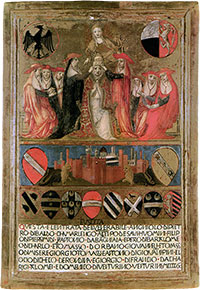 Tavoletta di Biccherna - Vecchietta, Incoronazione di Pio II, veduta di Siena fra due chimere, Archivio di Stato di Siena, 1460 Tavoletta di Biccherna - Vecchietta, Incoronazione di Pio II, veduta di Siena fra due chimere, Archivio di Stato di Siena, 1460
|
| |
|
|
|
|
|
| |
|
Palazzo Piccolomini in Pienza
|
|
|
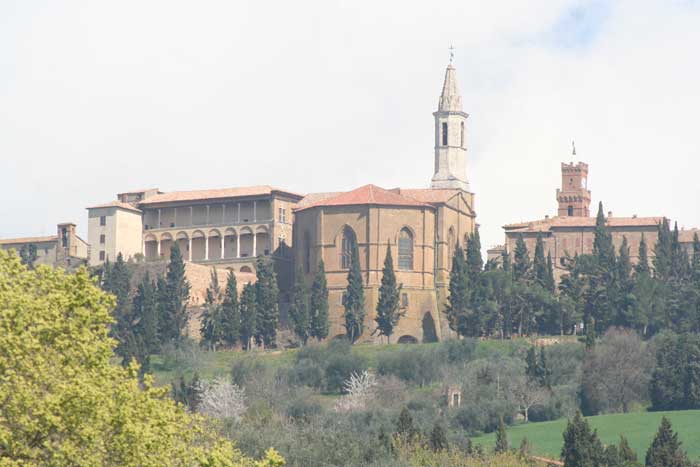 |
|
The trapezoidal Piazza Piu II in Pienza is defined by four buildings. The principal residence, Palazzo Piccolomini, is on the east side. It has three stories, articulated by pilasters and entablature courses, with a twin-lighted cross window set within each bay. This structure is similar to Alberti's Palazzo Rucellai in Florence and other later palaces. Noteworthy is the internal court of the palazzo. The back of the palace, to the south, is defined by loggia on all three floors that overlook an enclosed Italian Renaissance garden with Giardino all'italiana era modifications, and spectacular views into the distant landscape of the Val d'Orcia and Pope Pius's beloved Mount Amiata beyond. Below this garden is a vaulted stable that had stalls for 100 horses.
The Duomo (Cathedral), which dominates the center of the piazza, has a façade that is one of the earliest designed in the Renaissance manner. Though the tripartite division is conventional, the use of pilasters and of columns, standing on high dados and linked by arches, was novel for the time. The bell tower, however, has a Germanic flavor as is the layout of the Hallenkirche plan, a "triple-nave" plan where the side aisles are almost as tall as the nave; Pius, before he became pope, served many years in Germany and praised the effects of light admitted into the German hall churches in his Commentari.[2] Works of art in the duomo include five altar paintings from the Sienese School, by Sano di Pietro, Matteo di Giovanni, Vecchietta and Giovanni di Paolo. The Baptistry, dedicated as usual to San Giovanni, is located next to the apse of the church.
Pius encouraged his cardinals to build palazzi to complete the city. Palazzo Vescovile, on the third side of the piazza, was built to house the bishops who would travel to Pienza to attend the pope. Its construction was financed by Cardinal Rodrigo Borgia (the future Pope Alexander VI but, at the time, Vatican Vice-Chancellor). It may represent a remodeling of the old town hall of Corsignano. It is now home to the Diocesan Museum,[3] and the Museo della Cattedrale. The collection includes local textile work as well as religious artifacts. Paintings include a 12th-century painted crucifix from the Abbey of San Pietro in Vollore, 14th century works by Pietro Lorenzetti (Madonna with Child) and Bartolo di Fredi (Madonna della Misericordia). There are also important works from the 14th and 15th centuries, including a Madonna attributed to Luca Signorelli.
Across from the church is the town hall, or Palazzo Comunale. When Corsigniano was given the status of an official city, a Palazzo was required that would be in keeping with the "city's" new urban position, though it was certainly more for show than anything else. It has a three-arched loggia on the ground floor facing the Cathedral and above it is the council chamber. It also has a brick bell tower that is shorter than its counterpart at the cathedral, to symbolize the superior power of the church. The set-back addition to the tower dates from 1599. It is likely that Bernardo Rossellino designed the Palazzo Comunale to be a free dsstanding civic mediator between the religious space before the cathedral and secular market square to its rear.
The travertine well in the Piazza carries the Piccolomini family crest, and was widely copied in Tuscany during the following century. The well-head resembles a fluted, shallow Etrucan Bowl. The flanking Corinthian support a classical entablature columns whose decorations are clearly based upon actual source materials
The summer residence of Enea Silvio Piccolomini, Pope Pius II, Palazzo Piccolomini in Pienza is the first example of Renaissance architecture.
Built in 1459 by famed architect Bernardo Rossellino, student of Leon Battista Alberti, recent major renovation has restored its utmost splendour, both internally and externally.
The architectural complex is presented as the realisation of Pius II’s ambitious humanist project for the ideal city.
The Piccolomini family lived in the Palazzo until 1962 when, by testamentary dispositions, it was transferred to the Ente morale di Siena Società di Esecutori di Pie Disposizioni.
The true architectural theme of Palazzo Piccolomini is its relationship with nature and the landscape. From the portico on the rear, unfolds an extraordinary view of the Valdorcia and Monte Amiata. Inserted into this panorama, on the ground floor of the palazzo, a square-shaped garden bound by walls with a well in the middle, is the first hanging garden of the Renaissance.
This situation lends this place a symbolic, architectural and blissful value, one of harmonious life amidst nature (from “Pienza, city of Pius” by Jan Pieper).
On the ground floor, the inner courtyard and rooms present the architectural structure; several exhibition stations illustrate Pius II’s ambitious humanist project for the ideal city. The first floor is the location of the appartamento nobile where the halls open onto the rooms: the dining room, the music room, the study, the weapons room, the library, and several bedrooms, including that of Enea himself. The piano nobile rooms are furnished with antiques of the period, paintings, objets d’art, and many tokens of a past that still remains intact.
Opening Hours
OCTOBER 16 – MARCH 14
TUESDAY – SUNDAY: 10 am – 4:30 pm
No admission after 4 pm - Closed on Mondays - Open on holiday Mondays
MARCH 15 – OCTOBER 15
TUESDAY – SUNDAY: 10 am – 6:30 pm
No admission after 6 pm - Closed on Mondays - Open on holiday Mondays
December 25 / January 1, open 2 – 6 pm
No admission after 5:30 pm
Palazzo closed from January 7 to February 14 and from November 16 to November 30
. |
|
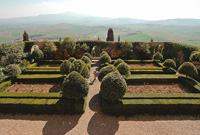
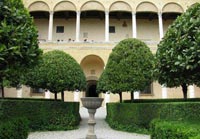
Piccolomini garden
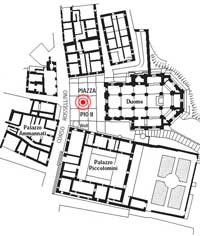
|
|
|
|
|
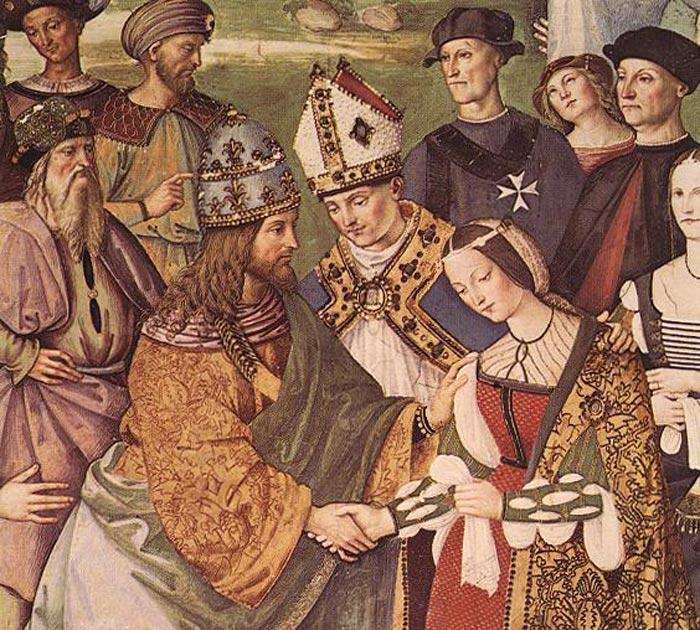 |
Aeneas Piccolomini Introduces Eleonora of Portugal to Frederick III (detail), fresco in the Piccolomini Library, Duomo, Siena
|
In the recently restored Piccolomini Library Pinturicchio's fresco cycle is a rare example of a unified decoration of the early sixteenth century. Well-suited to Pinturicchio's skills and to a somewhat provincial Siena, his lyric style fits comfortably into the medieval setting of the Cathedral. The subject matter concerns incidents in the life of Pius II, the Sienese pope and humanist, an unusually complete program for someone neither a saint nor a ruler.
The donor of the library and its furnishings was Francesco Todeschini (1439-1503) who wished to create a monument to his family and a memorial to his mother's brother Enea Silvio Piccolomini who had served as Pope Pius II from 1458 to 1464. In 1460 Pius II elevated Todeschini to the rank of cardinal and permitted him to assume the Piccolomini name and the family's coat of arms. In 1503 Francesco succeeded Pope Alexander VI as Pius III but his reign was brief, he died twenty-six days later.
The contract for the decoration of the library was signed in the presence of Francesco Todeschini-Piccolomini on June 19, 1502 and the painting was finished in April 1508.
The source for the ten episodes from the life of Pius II was Pius II's autobiography, the famous Commentarii, written between 1462 and 1464. In addition to being the official life story of a pope, it is a fascinating political and historical chronicle. The narratives are illustrated with descriptive clarity, the figures precisely drawn, the unatmospheric landscape bright and sharply defined.
The entrance to the Piccolomini Library is located in in the left aisle of the cathedral in Siena. The monumental fresco above the richly carved classical façade depicts the coronation of the library's donor, Francesco Todeschini-Piccolomini, as Pope Pius III. In the lunette above the portal the donor's coat of arms as cardinal, in the right-hand lunette the papal coat of arms of his uncle Pius II can be seen.
The fresco records an event that took place on October 8, 1503 in front of the old St Peter's. The painter must have executed this work at the behest of the heirs, for the new pope died a mere ten days after the event depicted. The fresco was heavily overpainted in the sixteenth and nineteenth centuries, and it was restored in the 1960s.
Even before he built the library, Cardinal Francesco Todeschini-Piccolomini had acquired the collection of antiquities that had belonged to Prospero Colonna in Rome. One of the highlights of the collection was the famous marble group of the Three Graces. The cardinal later moved the group to the library in Siena.
The library vaulting, distinguished by its wealth of colour and figures, is one of the earliest surviving examples of a deliberate and very precise imitation of classical design. It has yet to be determined whether the figures and scenes incorporated into the picture compartments of the library vaulting represent some specific iconographic concept or simply arbitrary borrowings from classical models.
The decoration consists of grotesque decor, donor coats of arms, dedicatory inscription, allegorical and mythological scenes.
Art in Tuscany | Pinturicchio, Frescoes in the Piccolomini Library of the Duomo in Siena
|
|
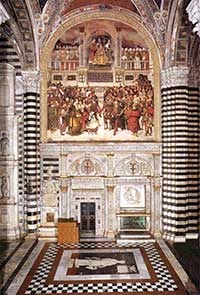
Entrance to the Piccolomini Library,
Duomo, Siena

Detail of vault of the Piccolomini Library painted by Pinturicchio (c.1502). At upper left is the Rape of Proserpine; at upper right is the coat of arms of the Piccolomini family. Duomo, Siena, Italy.
 Piccolomini Library Piccolomini Library
|
|
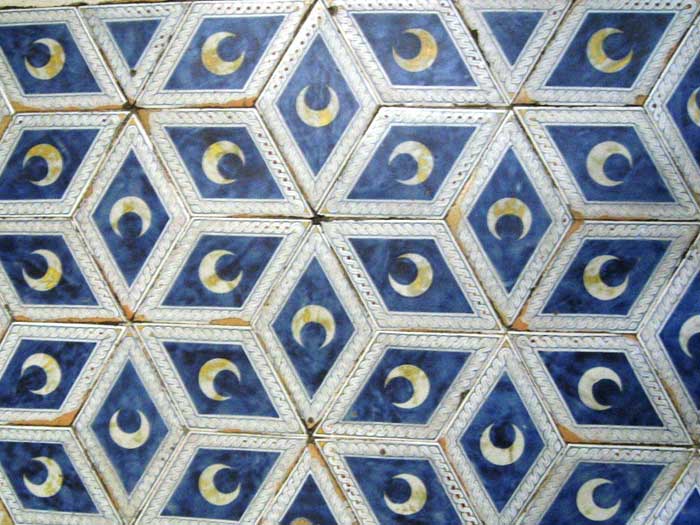 |
Pinturicchio, ceramic floor of the Piccolomini Library (detail), Duomo, Siena |
|
|
| |
|

Gardens in Tuscany | Palazzo Piccolomini Garden in Pienza
Website Palazzo Piccolomini in Pienza | www.palazzopiccolominipienza.it

[1] Bernardino di Betto, known as Pinturicchio (Perugia 1454-1460, Siena 1513), had an artistic career crowned by great achievements, demonstrated by his continual activity as artist under five Popes: from Sisto IV to Giulio II, to Innocent VIII and Alexander VI, of whom he was the favourite artist, and the very brief pontificate of Pius III, already his commissioner for the Libreria Piccolomini in Siena. He was unjustly confined for a long time to a secondary position in the art scene, because of negative judgements, or at least somewhat limited. Finally, at the end of the nineteenth century, he was able to acquire fame, thanks largely to foreign art critics.
An attentive, impartial examination of his works reveals a very original artist with a multifaceted personal figurative language, which blends minute traces of Flemish art and late gothic elegance, with innovative Renaissance geometry and impressive sceneries.
His unfavourable reviews are strictly related to his success. He had an uncommon managerial capacity and was involved in numerous and large cycles of frescoes, compelling him to use many apprentices with varied artistic talent. This was the cause of the frequent disparity of quality found in his works.
|

The ultimate Italy Villa Rental. Podere Santa Pia, a formal cloister in the Tuscan Maremma with a view made in heaven is the perfect holiday resort for relaxing and enjoying the splendor of the Maremma hills of southern Tuscany.
Artist and writer's residency | Holiday houses in Tuscany | Podere Santa Pia
|
| |
 |
|
|
|
|
Siena, Palio |
|
Podere Santa Pia |
|
Podere Santa Pia, view from the garden on the valley below
|
|
|
|
|
|
|
|
|
|
|
Siena, Duomo |
|
Siena, Palazzo Sansedoni
|
|
Corridoio Vasariano, Firenze |
| |
|
|
|
|
|
|
|
|
|
Palazzo Medici Riccardi, Florence |
|
Piazza della Santissima Annunziata
in Florence |
|
Florence, Duomo |
| |
|
|
|
|
This article incorporates text from Wikipedia article Pope Pius II and from the Encyclopædia Britannica, Eleventh Edition, a publication now in the public domain, and WikiCommons Cathedral (Siena) - Piccolomini Library (71 F)
Wikisource has original works written by or about: Pope Pius II |
|
|






